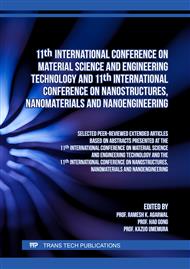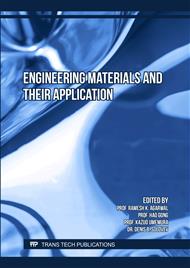p.21
p.29
p.35
p.41
p.51
p.57
p.67
p.75
p.85
Morphology and Properties of Poly(Lactic Acid) and Polybutylene Succinate and Ethylene-Co-Methyl Acrylate-Co-Glycidyl Methacrylate Ternary Blends
Abstract:
This work studied the morphological, mechanical, and thermal properties of poly(lactic acid) (PLA)/polybutylene succinate (PBS)/ethylene-co-methyl acrylate-co-glycidyl methacrylate (EMA-GMA) ternary blends. The polymer blends were prepared in an internal mixer and then molded into films by compression molding. The results showed that the PLA/PBS blends had immiscible morphology in which the PBS phase was dispersed in PLA matrix as spherical shape. The PBS droplet size increased with increasing PBS content. The fractured surface of PLA/PBS/EMA-GMA blends displayed more small crack of plastic deformations than that of PLA/PBS blends and the fracture behavior of PLA/PBA blends was changed to more ductile fracture when added with EMA-GMA. The addition of EMA-GMA in polymer blends improved the compatibility of two phases. The results of the mechanical properties showed that PBS and EMA-GMA addition improved the strain at break of PLA/PBS and PLA/PBS/EMA-GMA blends, respectively. The incorporation of EMA-GMA had no effect on the melting temperature and degradation temperature of PLA blends. The PLA/PBS/EMA-GMA blends had lower percent crystallinity than that of PLA/PBS blends and most of percent crystallinity decreased with increasing EMA-GMA loading due to its more amorphous structure than PLA and PBS.
Info:
Periodical:
Pages:
51-56
Citation:
Online since:
May 2023
Price:
Сopyright:
© 2023 Trans Tech Publications Ltd. All Rights Reserved
Share:
Citation:



